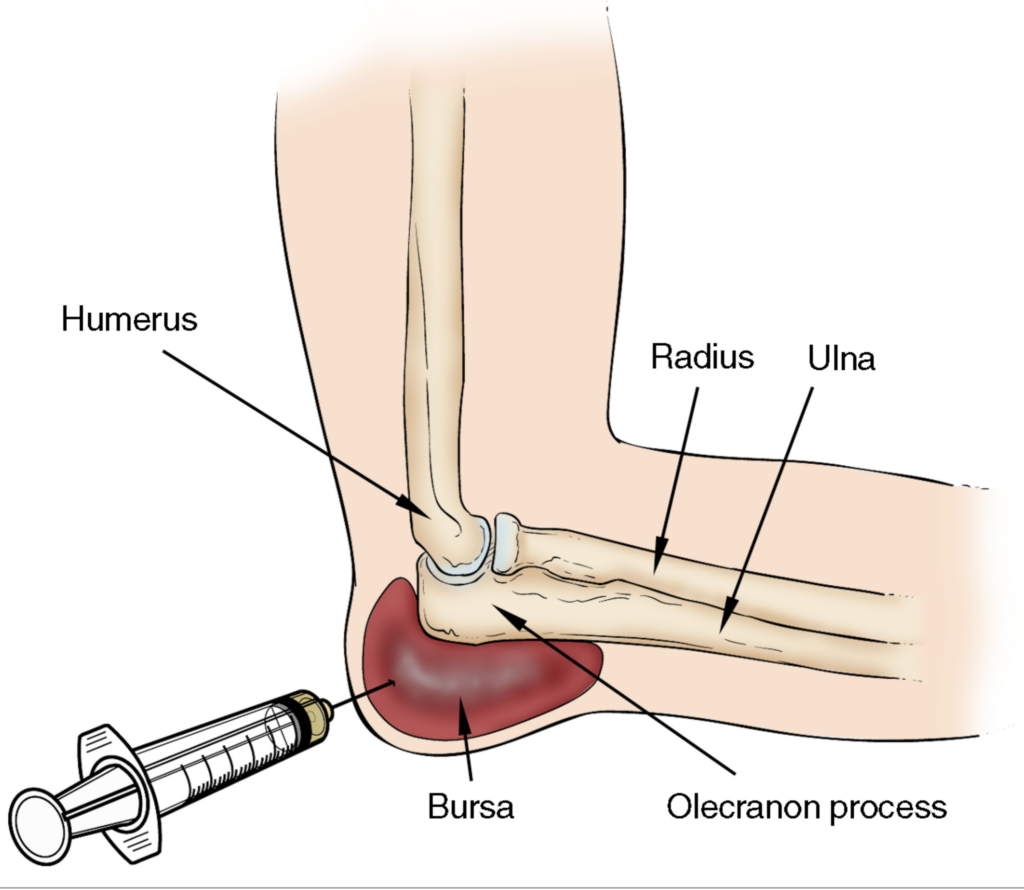
What is Olecranon Bursitis of the elbow?
Olecranon bursitis is a condition of the elbow that presents as a ‘bulbas’ (golf ball like) swelling on the point of the elbow bone. The swelling is a fluid filled sac called a bursa that will feel soft but can cause pain, redness and tenderness to touch.
Anatomy of the Elbow
The olecranon bursa is a small sac that is located at the elbow’s pointy tip, just beneath the skin. It is named after the olecranon – the large, rounded end of the ulna bone in the forearm – the bone that you lean on when resting on your elbow.

There are a number of bursa in the body; they help to reduce friction and ensure there is smooth movement between the bones and the soft tissues such as tendons, ligaments and skin. They also act as a protective pad which reduces the risk of injury from direct impact.
What causes Olecranon Bursitis?
Elbow bursitis is the most common type of bursitis. It occurs when the membrane of the olecranon bursa becomes irritated and inflamed. The inflamed membrane causes excess synovial fluid to be produced, making the bursa swell. In severe cases olecranon bursitis can cause the elbow to swell to the size of a golf ball. Most often it is caused by either over use or trauma.
Common causes:
Trauma – Such as a direct blow on a hard surface or a fall, landing on your elbow
Overuse – Prolonged, repeated pressure over the olecranon bursa, can also occur in people who rest their elbow on a hard surface for a long period of time. This includes office workers who do a lot of writing or typing, or plumbers or mechanics whose work requires them to lean on their elbows excessively. It is also common in people who play sports that require repeated elbow movement, like tennis players, baseball players, or golfers.
Infection – This must be ruled out in ALL olecranon bursitis.
The bursa becomes infected from a cut, scratch, or insect bite. This will cause the sac to fill up with extra fluid, become painful, red and swollen. If the infection goes untreated, the fluid can turn to pus. Infected bursitis requires prompt treatment to prevent it from spreading around the body.
Medical conditions – If you have another condition such as rheumatoid arthritis, diabetes, thyroid disease, or gout, this can make you more susceptible to getting bursitis.
What are the symptoms of Olecranon Bursitis?
- Swelling over the elbow – This is often the first symptom to be noticed.
- Pain – Which is increased when touching or leaning on your elbow. Pain may also be worse when the elbow is fully bent or fully straightened; especially the latter, as it compresses the bursa.
- Reduced elbow movement – As the swelling grows, it may start to restrict elbow movement.
- Redness and increased skin temperature – These are often associated more with infected bursitis. You may also develop a fever with the infection.
If you are suffering from any of the symptoms described, then please don’t hesitate to contact us to book an appointment 0207 482 3875. Or if you would like to discuss your symptoms then please email us with your details and we will get back to you. info@complete-physio.co.uk.
If you have signs of an infected bursa i.e the elbow is red and hot as well as swollen, then you should see your GP straight away or attend A & E. If untreated it can cause significant problems. Initially, medical management for an infected bursa is antibiotics. In some cases, an infected bursa may require an operation to remove the infected fluid.
How is Olecranon Bursitis diagnosed?
Due to the location of pain, and the distinctive nature of the swelling and symptoms, olecranon bursitis is fairly easy to diagnose, and your specialist will be able to do this at your initial physiotherapy appointment.
Your Physiotherapist will ask you to describe the onset of your symptoms and the pattern of pain and swelling. In addition, information about your medical history, occupation, and hobbies will help provide important clues as to whether you have olecranon bursitis, and if it might be infected.
This subjective assessment will be followed by a clinical examination which may include:
- Looking for redness or swelling around the elbow.
- Assessing your elbow range of movement.
- Gently feeling around the elbow joint to closer examine the area and assess for any heat or signs of infection.
- Assessing the muscle strength of your hand, wrist and arm.
- Looking more globally at other parts of the body, such as your shoulder or neck, that might also be affected or contributing to your symptoms.
As previously mentioned, aseptic (non-infected) olecranon bursitis, secondary to overuse or trauma, is the most common cause of symptoms. However if there is not a clear mechanism of injury, your physiotherapist may want to request further tests.
X-rays
These can be useful to look for a foreign body that may be causing the bursitis. It will also identify a bony spur, osteoarthritis or to rule out a broken bone.
Fluid testing
This is done by taking a sample of bursal fluid with a needle to diagnose whether the bursitis is caused by infection. By removing (aspirating) some of the fluid, this will also often relieve some of the symptoms too. This is generally carried out by an orthopaedic consultant.

Will I need a scan?
Medical imaging is not required for an accurate diagnosis in most cases, however an ultrasound scan can help to confirm the diagnosis and also look more closely at the severity of the swelling and inflammation.
Diagnostic musculoskeletal ultrasound is the best imaging technique for an olecranon bursitis. Diagnostic ultrasound is an evidence-based imaging modality which has been proven to be highly effective at assessing bursal pathology. It can be used to assess swelling and inflammation, and is an excellent tool to help differentiate between olecranon bursitis and other inflammatory conditions such as gout.

At Complete Physio we have a team of experts who are dual trained as physiotherapists and musculoskeletal sonographers. During your initial assessment your clinician will be able to clinically assess your elbow and also perform a diagnostic musculoskeletal ultrasound scan at the same time, therefore providing you with an accurate diagnosis of your pain and symptoms. We do not charge extra for an ultrasound scan.
If you would like more information or would like to book an appointment please contact us on 0207 482 3875 or email info@complete-physio.co.uk. You don’t need a GP referral, however please let us know if you would like to be booked in to see one of our clinical specialists.
How is Olecranon Bursitis treated?
Treatment is dependent on your exact diagnosis, which is why it is vital that you see a specialist who can accurately identify the cause of your symptoms.
If there is no infection present then you will likely respond very well to conservative management such as Physiotherapy, and nonsteroidal anti-inflammatory medication.
With septic i.e infected olecranon bursitis, it requires medical management via your GP or orthopaedic consultant, with the majority of septic cases being well resolved with aspiration and a course of antibiotics. In the rare occasions where this fails to resolve symptoms, surgical management may be required.
With the correct management you will be able to lead a very functional, less painful and highly enjoyable life, doing many of the activities that you normally do.
Physiotherapy
Your physiotherapist at Complete will provide you with a personally tailored treatment plan based on your clinical assessment. This will often include:
- Ice – This will help to reduce your pain and swelling

- Rest and activity modification – You will need to avoid activities that aggravate your symptoms, this may mean that you need to reduce, or stop playing a particular sport, or modify how you do a certain task.
- Medication – Over-the-counter medication such as painkillers and anti-inflammatories can also ease pain and inflammation.
- Patient education – It is important to understand your condition; you will be given a clear explanation of the diagnosis, and we will discuss what is required to address your symptoms and reach your goals.
- Range-of-movement exercises – If you have a limitation in your elbow movement, your physiotherapist will teach you active, self-stretching techniques to help improve elbow joint movement. They may also do some hands-on, passive stretches with you. It is very important that you regain and maintain full movement in the elbow and any other stiff joints.
- Muscle strength exercises – If you have muscle weakness alongside your olecranon bursitis or other associated conditions, your physiotherapist will design a progressive resistance program to ensure all your upper limb muscle groups are strong and working in synergy.

- Taping – Specific taping techniques may help to reduce elbow swelling.
- Functional rehabilitation – Once your symptoms have settled and you have regained a good level of strength and movement, your physiotherapist will start to work on more functional exercises to get you back to the activities, job or sport that you love.
If your swelling and pain do not respond to these conservative measures then there are other treatments that we can offer at Complete Physio.
Ultrasound Guided Procedures for Olecranon Bursitis
Ultrasound-guided bursal aspiration (removing fluid) and corticosteroid injection are often considered for Olecranon bursitis. However, most of the time these are not required and they do have associated risks (greater than other injection procedures). Injection procedures are only considered if all conservative treatments have failed and we are 100% sure it is not infected. We only carry out this procedure if you have been referred by a specialist medical professional i.e a sports medicine consultant or an orthopaedic surgeon. You cannot book in directly for this injection procedure for an olecranon bursitis. All cases are screened by one of our clinical specialists.
Bursal Aspiration
During this procedure an ultrasound scan is used to create real time imagery of your olecranon bursa, which allows accurate needle placement. Excess fluid is then withdrawn from the bursa. This helps to reduce the pressure within the busa and reduce your pain.
Steroid Injection
If required, a combination of local anaesthetic (numbing agent) and a small dose of corticosteroid (a strong anti-inflammatory medication) can also be injected at this point. Ultrasound-guided corticosteroid injections are routinely used within musculoskeletal medicine, for the treatment of bursitis, and are an effective way to reduce pain and inflammation associated with this condition.
Olecranon Bursitis Surgery
Surgery is very rarely required, however, in persistent cases, removing the bursa – known as a bursectomy, can be performed.
If an onward referral is required we will ensure that you are provided with exceptional care from one of the highly experienced ,Orthopaedic Consultants who we work very closely with. You will require physio rehabilitation following your surgery, and so we will continue to support your post-op recovery every step of the way.
If you would like to book an appointment at Complete Physio or if you would like to speak to a member of our team, please call 020 7482 3875 or email info@complete-physio.co.uk.
Don’t let pain hold you back, book now!






